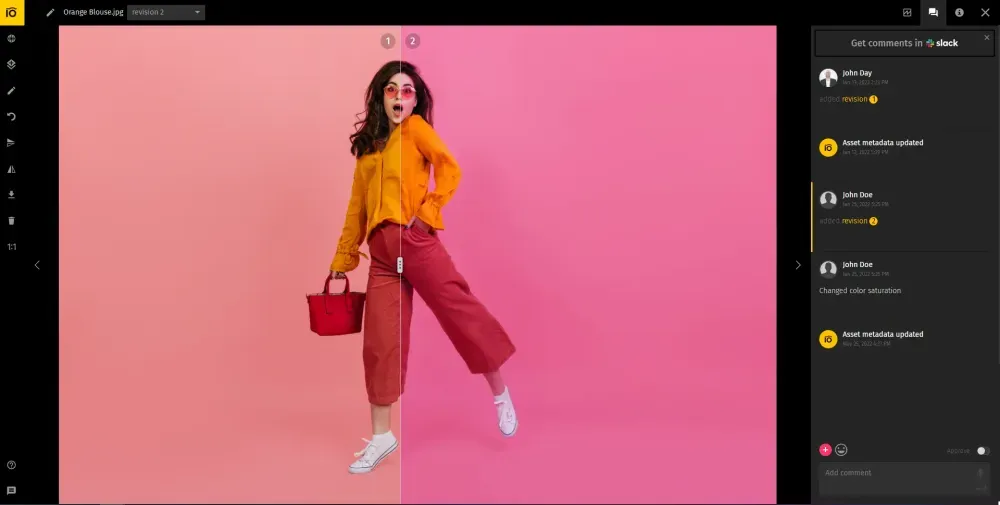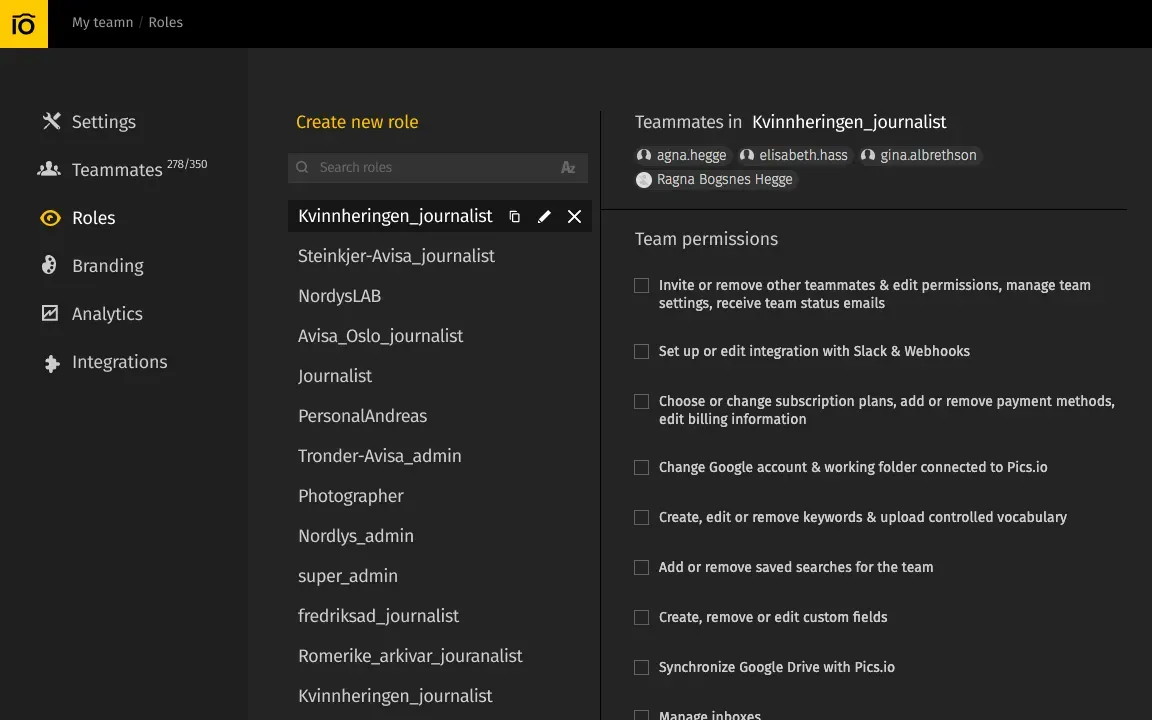Editor’s note: This is a significantly updated edition (Oct 2, 2025): revised Drive label limits, new integration notes, and a faster chooser section.
If you already think of digital asset management, Google Drive is a thing of the past. It is the go-to option for anyone in need of a no-brainer cloud storage space and file management. It is not super fast, but it is convenient, and everyone knows how to use it. However, you might have reached its limits, and the digital asset management capabilities of Google Drive are no longer enough to handle your tasks. Now what?
Google Drive, DAM, or both together? Quick pick
- Choose Google Drive if… You are a small team that needs affordable and low-friction file storage, along with basic collaboration and sharing features.
- Choose a DAM if… You are a 10+ creative team, produce visual assets at scale, need metadata-driven search, review workflows, web portals, granular permissions, and AI automation (face recognition, AI tagging, etc.)
- Choose a DAM that integrates with Google Drive (like Pics.io) if… You depend on Google Docs, Sheets, or Slides, but would like to turn your Google Drive into a full-fledged DAM, avoiding migration hassle and dependency on third-party storage vendors.
| Criterion | Google Drive (GD) | Digital Asset Management (DAM) | DAM with GD as storage (GD+DAM) |
|---|---|---|---|
| Primary job | General file storage & collaboration | Manage, govern & distribute rich media | DAM features while keeping Drive as storage |
| Search | Filename + basic properties | Metadata, tags, custom fields, facets, EXIF/IPTC/XMP | DAM-grade search on top of Drive |
| Versioning | Basic history | Full version control for Google Drive files, compares, approvals | Same as DAM |
| Sharing | Link sharing + basic permissions | Branded portals, expiring links, watermarks, download presets | Same as DAM, with Drive as source |
| Security | Folder permissions | Roles, rights/expiry, SSO/MFA, audit logs | Same as GD |
| Integrations | Google Workspace apps | Adobe CC, CMS, e-comm, PIM, ad platforms | DAM ecosystem plus native Drive/Workspace |
| AI features | Doc-centric AI helpers | Asset-centric AI (auto-tagging, smart crops, dedupe) | Same as DAM |
| Speed & Performance | Fine for internal access | CDN delivery, cached derivatives, signed URLs | Same as GD |
| Cost | Low per seat; minimal setup | Higher license; lower rework at scale | Mid–high; avoids migration/dup storage; strong ROI for media-heavy |
Google Drive has the edge in terms of simplicity and price.

Google Drive's digital asset management service provides cloud-based storage, along with a free plan of up to 15 GB, and a plethora of integrated free office apps, mail, AI, and more, as part of Google Workspace. It is used by individuals as well as all organizations of all sizes due to its accessibility, ease of use, and affordable entry price.
Stable and reliable
Let’s be honest: if Google goes out of business, we’ll have more pressing issues than figuring out where to keep our files. When you use Google, you can be confident that your digital files will be safe and secure, and will remain so for a long time to come.
Affordable
As of September 2025, the Business Starter plan starts at $7 per user monthly, with 30GB per seat (pricing varies by region and billing—see Google’s official pricing). So, with a team of 10 people, you’d be paying ~$70 monthly, which isn’t that much, especially considering all extra office apps that come with a Workspace subscription.
Simple Collaboration
As a digital asset library, Google Drive gives you a no-nonsense way to share files with others via link generation. For text files and presentations, there are even built-in collaboration features that let you work on the same project in tandem with others.
Google Drive is neat because it gives a little bit of everything. Storage, collaboration with others, file sharing, and, with how ubiquitous it is, you never have to worry that a new colleague doesn’t know how to use it.
When “Just Drive” Isn’t Enough: metadata, versioning, access control
If Google Drive is so good, why do we need anything else? Nobody’s perfect. On one hand, you have simplicity, widespread adoption, and affordable storage. On the other hand, for managing media files and metadata, Google Drive is not an optimal solution.
With more content creators on the team and files in storage, you inevitably reach a point where finding assets in your centralized content hub becomes a challenge that requires an unreasonably large amount of time and effort.
Improved Discoverability
DAM systems utilize metadata (keywords, tags, descriptions, custom fields, etc.) to make brand assets easier to find. So, instead of locating files by a match in the file name, you can now:
- search by a match in metadata (including AI-generated fields);
- use additional filters to refine search results (filetype, created by, rating, status, etc.);
- Find assets using visual search, similar to Google's natural language search.
According to our internal estimate, DAM is going to save you 10 hours/month. A client of ours, Kavak, reported that their marketing department, comprising approximately 70 people across graphic design, store management, and data production branches, saves about 8 hours per week per person. These are the hours that users would have spent searching for assets or recreating them from scratch.
Version Control
In DAM solutions, all revisions of an asset are kept under a single thumbnail. It helps keep your digital library clean, with minimal to no duplicates. Besides, proper versioning prevents broken links — you update the file in DAM and all existing links point to the latest version of it.

Improved Collaboration Features
Google Drive nailed collaboration on text documents. But as for videos and other media assets? It is somewhat lacking. The DAM solution features dedicated tools to help your team collaborate while producing videos or images, allowing you to leave comments on the timecode and add visual tags directly to images. Thus, DAM facilitates collaboration for both internal and external partners.
Better Permission Management
In the DAM system, rights and permissions are much more granular. You can create roles or tweak permissions for specific users manually. Also, you can protect your content with a password and/or watermarks. Finally, DAM provides advanced protection and analytics to share and guard embargoed content. So, you can ensure no leaks ahead of time.

Even Better Sharing
Google Drive allows you to share a file or a folder with a few clicks. With a proper DAM system, you can do it much better and more conveniently.
For starters, let’s take a look at sharing portals — the branded websites that let you distribute selected content from different folders that have common features (tag, type, format, etc.) Anyone with a link to the sharing portal will see an interactive gallery where they can view, search, and comment on assets the same way that you would in your DAM solution.
Additionally, there are file upload forms (inboxes) that allow non-DAM users to upload files directly to the selected collection in your DAM. Best part? You can impose the filling out of obligatory fields, so the assets can be found faster in the future.
DAM Dominates in Speed, Performance, and Security
Speed
Digital asset management platforms outperform Google Drive and DAMs that work on top of it in overall speed because:
- DAM avoids Google Drive API calls, which slow down performance
- It shows pre-sized copies (thumbnails) instead of heavy original files
- A DAM solution employs CDN, so files are served from the closest server.
Performance
Drive handles everyday files well, but it slows down when you edit many large assets or run changes one by one. A DAM speeds this up with batch tools: you apply metadata to many files at once, and renditions are created automatically on upload. This cuts manual steps and keeps links intact.
With GD+DAM, the DAM takes on the heavy lifting while Drive as storage casts some limitations (mostly API-wise). It overall shows better performance than the Google Drive alone, but still works slightly slower than the proprietary cloud storage native to a DAM solution.
Security
Drive is quite comfortable for internal sharing due to its Workspace ACL, but it falls short when a more fine-grained approach is required. Watermarks and password protection are among the most sought-after features that DAM provides for secure sharing. Besides, Google AI wouldn’t certainly learn from your assets, in the case of a DAM cloud storage.
Google Drive+Digital Asset Management strengthens the security with audit logs, SSO, and protected sharing. However, the Drive as a backdoor remains a risk factor.
Google Drive+DAM: best for integrations, no storage lock-in and no migration
Expanded integrations with Google Workspace
You keep everything you love in Workspace—Docs, Sheets, Slides—and add DAM power on top. By using plugins as a connection, you can access your Google Drive DAM straight from Google Suite products. It is as simple as using native integrations with the added benefit of improved metadata-driven search. So you can find the right asset in seconds
DAM integrates on top of your Drive storage
Your files stay in Drive. The DAM indexes them, adds metadata and approvals, and syncs changes both ways. No migration, no file renames, no broken links—Drive IDs remain stable across your tools.
You can onboard by pointing the DAM at your current folder tree. For example, when you sign up for the Pics.io account, you will be prompted to sync up the Google Drive folder. The software will read the content and recreate structures. So, you’re ready to go in hours, not weeks, and your assets are exactly where you left them.
Keeping Your Storage is Free
With traditional digital asset management (DAM), you must purchase the provider’s storage. So, if you already own a Google Drive storage, you’ll have to either double-dip or abandon your existing solution to avoid overpaying.
With Pics.io’s DAM Google Drive offering, that is not an issue. You keep your Google Drive as cloud storage, and you don’t have to pay extra for its storage. This is called Bring Your Own Storage or BYOS.
No vendor lock-in
With a digital asset management platform that works on top of Google Drive, your assets are not becoming hostages of a proprietary storage imposed by a DAM vendor. If you no longer need Pics.io, you won’t have to worry about transferring files back and forth, as they will be right where they always were — in your Google Drive folder.
Google Drive, DAM, or both? A 30-second decision guide
Choose Google Drive if
- Your digital asset library is up to 1TB
- The number of content creators and contributors is up to 3 people
- Your content is mostly not visual (Docs, Sheets, Slides, Forms, etc.)
- You don’t have a sustainable content production workflow
- You are tight on budget
Choose a Digital Asset Management if
- Your Google Drive is no longer effective in finding files or searching for assets, as it takes an unreasonably long time.
- You need to streamline your digital asset workflows, which include asset review, collaboration, and approval.
- You have multiple content creators or even teams that produce a decent amount of content, so that your library can quickly become a mess without proper governance.
- The work of your team is often disrupted by your colleagues or partners who can’t locate the necessary files in your public Google Drive folders.
- You get a lot of broken links or complaints about them.
- The links to outdated visuals circulate long after the assets were deprecated.
- You want to quickly update the images on the site without needing to access the admin panel.
Choose a DAM with a Google Drive as a storage (like Pics.io) if
- You want all the benefits of a proper DAM platform, while keeping your visual assets on Google Drive is a priority.
- If your library becomes very big (petabytes, not terabytes), you will be OK with a slightly slower sync speed and content updates in folders.
- You are tight on budget and have already been paying for the Google Drive storage.
FAQ
How to use Google Drive as a DAM?
Google Drive can serve as a digital asset management system for individual use or when you have just a few content contributors (2-3) and your content library is small (<1TB). However, it cannot serve as a proper alternative to a digital asset management system for teams with large-scale content production.
Certain DAM providers (like Pics.io) offer a seamless way to integrate your Google Drive library into a DAM interface and use it as a storage. It introduces sophisticated media management functionality, while your library stays on Google Drive.
What is a better way to organize the Google Drive library?
Use Shared Drives, keep folders shallow (Team → Year → Project), and name files with a simple pattern (e.g., YYYY-MM-DD_Project_Asset_Status_v01). Give access via Google Groups to the project folder, keep one master file and use Shortcuts instead of copies, add a few labels for search, and archive closed work. If you need better search, approvals, and fast public sharing, add a DAM on top of Drive. Want a step-by-step checklist and templates? Download the Google Workspace Maximizer guide.
Does Drive support labels/meta?
Yes, Google DAM allows you to create up to 150 labels, with a maximum of 20 labels per file. You can apply up to 5 user-applied labels and 15 rule-applied labels. If you need additional ways to tag and locate your assets, consider using a Google Drive DAM, such as Pics.io.
Did you enjoy this article? Give Pics.io a try — or book a demo with us, and we'll be happy to answer any of your questions.
Author
John ShpikaJohn is the founder and CEO of TopTechPhoto Inc., the company behind Pics.io — a digital asset management platform for Google Drive. He is a software expert with 20+ years’ experience building and scaling digital products on Google Cloud. John holds a B.S. in Computer Science and is the author of the book “What Is Digital Asset Management?”. His work has been featured in TechCrunch, DPReview, CNET, and others.




